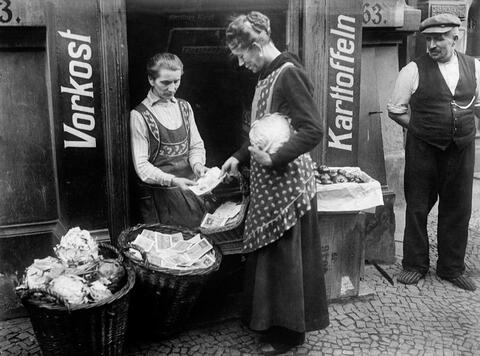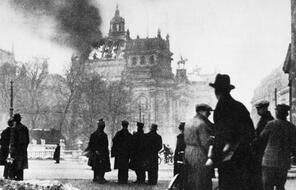When Money Had No Value
At a Glance
Language
English — USSubject
- History
- The Holocaust
- Human & Civil Rights
Beginning in the fall of 1922, an extreme inflation, or hyperinflation, took hold of the German economy. During periods of inflation, prices rise continuously as the value of a currency drops sharply. Many European countries experienced inflation after the war, but nowhere did prices rise as rapidly as they did in Germany. On some days, the value of the mark (the unit of German currency) fell almost hourly.
What caused the hyperinflation? During the war, rather than raising taxes and risking public anger, the German government had printed increased amounts of paper money to pay soldiers and to purchase guns, ammunition, and other supplies. After the fighting ended, there was more currency in circulation than there were things to buy. In addition, when Germany failed to make reparations payments to France, the French occupied the Ruhr (an industrial region in Germany rich in coal and iron ore). To show their outrage at the occupation, the German people responded with a general strike. During that strike, they produced almost nothing. So the few goods still available became more valuable. Prices skyrocketed and the mark purchased less and less. The enormous supply of German currency in circulation and the scarcity of goods meant that basic items like milk or bread that normally cost a few marks suddenly cost dozens of marks, and then hundreds, thousands, millions, and more.
As a result of the inflation, Germans who had their savings in banks or were living on pensions or disability checks found themselves virtually bankrupt. Workers increasingly discovered that no matter how high their wages rose, they could not keep up with rapidly soaring prices. According to Sebastian Haffner, a journalist and author who lived through the period:
Anyone who had savings in a bank or bonds saw their value disappear overnight. Soon it did not matter whether it was a penny put away for a rainy day or a vast fortune. Everything was obliterated . . .
The cost of living had begun to spiral out of control . . . A pound of potatoes which yesterday had cost fifty thousand marks now cost a hundred thousand. The salary of sixty-five thousand marks brought home the previous Friday was no longer sufficient to buy a packet of cigarettes on Tuesday. 1
Artist George Grosz described what shopping was like in those days.
Lingering at the [shop] window was a luxury because shopping had to be done immediately. Even an additional minute meant an increase in price. One had to buy quickly because a rabbit, for example, might cost two million marks more by the time it took to walk into the store. A few million marks meant nothing, really. It was just that it meant more lugging. The packages of money needed to buy the smallest item had long since become too heavy for trouser pockets. They weighed many pounds. . . . People had to start carting their money around in wagons and knapsacks. I used a knapsack. 2
The hyperinflation brought uncertainty to almost everyone. Victor Klemperer, a professor who kept a diary during those years, wrote in October 1923:
Germany is collapsing in an eerie, step-by-step manner. . . . The dollar stands at 800 million [marks]; it stands every day 300 million more than the previous day. All that’s not just what you read in the paper, but has an immediate impact on one’s own life. How long will we still have something to eat? Where will we next have to tighten our belts? 3
The government was able to bring the runaway inflation under control in 1924, but by then, prices in Germany had reach a billion times their pre–World War I levels. 4 And although there would be relative peace and prosperity in Germany for the next five years, the crisis had a lasting effect on many Germans. As one historian explains:
Hyperinflation became a trauma whose influence affected the behavior of Germans of all classes long afterwards. It added to the feeling in the more conservative sections of the population of a world turned upside-down, first by defeat, then by revolution, and now by economics. 5
Value of German Currency, 1919–1923
Date Marks US Dollars
1918 4.2 1
1921 75 1
1922 400 1
January 1923 7,000 1
July 1923 160,000 1
August 1923 1,000,000 1
November 1, 1923 1,300,000,000 1
November 15, 1923 1,300,000,000,000 1
November 16, 1923 4,200,000,000,000 1
- 1Sebastian Haffner, Defying Hitler: A Memoir (Farrar, Straus & Giroux, 2000), 55. Reproduced by permission from Farrar, Straus & Giroux.
- 2George Grosz, A Little Yes and a Big No: The Autobiography of George Grosz, trans. L. S. Dorin (New York: Dial, 1946), 63.
- 3Quoted in Richard J. Evans, The Coming of the Third Reich (New York: Penguin, 2003), 107. Reproduced by permission from Penguin Random House UK and Penguin Press.
- 4Quoted in Richard J. Evans, The Coming of the Third Reich (New York: Penguin, 2003), 109. Reproduced by permission from Penguin Random House UK and Penguin Press.
- 5Quoted in Richard J. Evans, The Coming of the Third Reich (New York: Penguin, 2003), 112. Reproduced by permission from Penguin Random House UK and Penguin Press.
Marketplace During Weimar's Hyperinflation

Marketplace During Weimar's Hyperinflation
A woman takes a basket of banknotes to buy cabbage at a market during the 1923 hyperinflation in Weimar Germany.
Connection Questions
- Define inflation in your own words. How did inflation change daily life in Germany?
- How does economic insecurity influence an individual’s decision making? How might it change an individual’s universe of obligation?
- How might economic insecurity make democracy vulnerable?
How to Cite This Reading
Facing History & Ourselves, "When Money Had No Value," last updated August 2, 2016.








